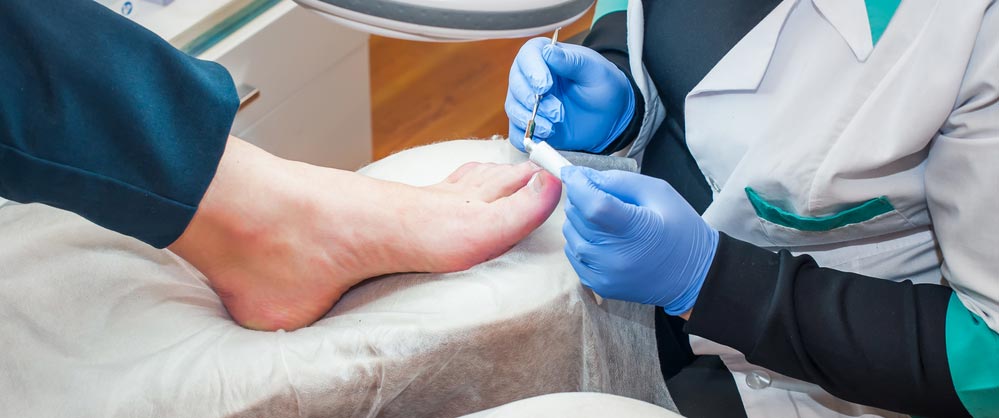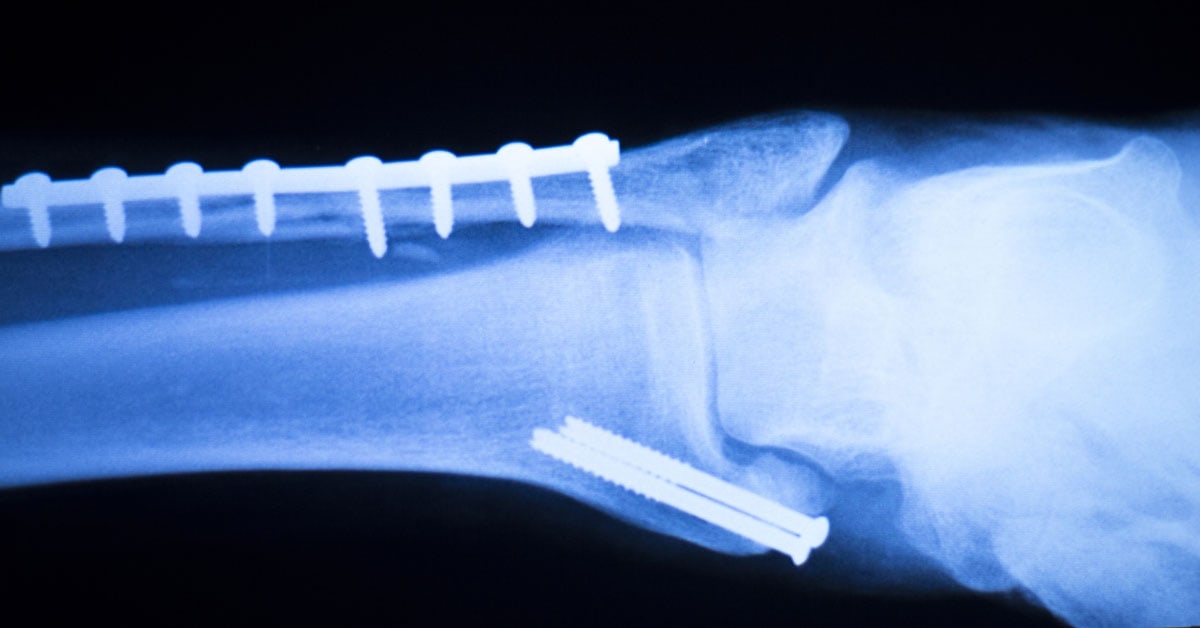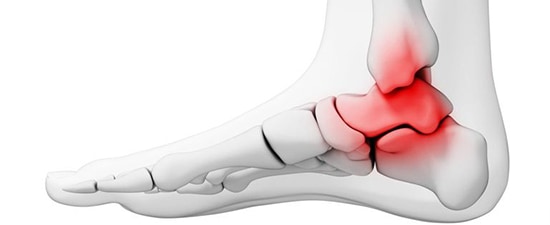- Home
- Foot & Ankle Conditions
- Fractures and Breaks
- Jones Fracture
Jones Fracture and Lisfranc Fracture: Causes, symptoms and treatment options
- Published 6/1/2018
- Last Reviewed 3/27/2024

What is a Jones Fracture?
A Jones fracture is a fracture that occurs at the base of the fifth metatarsal bone (the long bone on the outside of the foot that leads up to the pinky toe.) This common foot injury often affects elite athletes and weekend warriors.
This condition got its name from Sir Robert Jones, who studied and wrote about a fracture he and six others had in 1902 after a night of dancing.
This area receives poor blood supply, so healing can be difficult. And since a Jones fracture is very similar to a sprain or avulsion fracture (known as a "pseudo-jones" injury), it's critically important to be evaluated by an experienced orthopedic sports medicine foot and ankle specialist.
- Symptoms of a Jones Fracture
- What’s the difference between an avulsion fracture and a Jones fracture?
- Why are Jones fractures challenging to treat?
- What are the Jones fracture treatment options?
- What are the surgical treatment options for a Jones fracture?
- What is Jones Fracture Recovery?
- What is a Lisfranc Fracture
- Choose University Foot and Ankle Institute for Your Foot Care
- Why UFAI is your Best Choice for Foot and Ankle Care
- Jones fracture FAQs
- What foods help broken bones heal faster?
- How to increase blood flow to Jones fracture?
- How soon can I run after 5th metatarsal fracture?
- How did Jones Fracture get its name?
-
Foot and Ankle Surgeon at University Foot and Ankle Institute
Dr. Justin Franson, DPM, is a Board Certified Podiatric Foot and Ankle Specialist and Diplomate of the American Board of Podiatric Surgery. He attended the School College of Podiatric Medicine in Chicago, graduating in 2001. Dr. Franson then accepted a three-year residency program at the Greater Los Angeles VA and UCLA County Hospital.
Dr. Franson specializes in several areas including total ankle replacement and sports medicine. Treating athletes and weekend warriors like himself brings him a lot of joy. Dr. Franson keeps active with running marathons, triathlons, hiking, basketball, and golf.
Read Our Blog Articles About Breaks and Fractures
- Lawn Mowing Causes Lots of Foot Injuries: How to Stay Safe!
- 9 Tips to Help Find the Best Podiatrist for Your Foot Care
- 7 Causes of Inner Ankle Pain Revealed!
- Metal Surgical Screws and Pins May Become Thing of the Past
- 5 Reasons Why You Have Pain on the Outside of Your Foot
- 6 Common Foot Problems that Affect Men and Boys
- Expert Insights On Treatment Options For Cystic Lesions Of The Talus
- Tom Cruise Stunt Mishap Leads to Severely Broken Ankle. He Then Rejects Surgery. Why?
- Sports and Overuse Injuries of the Foot and Ankle
- 5 Signs your Ankle Sprain Might be a Fracture
- There’s nothing you can do for a broken toe...Or is there?
- Dr.'s Most Interesting Cases: the Heel that wouldn't Heal!
- What Your Feet Want You to Know about Playing Tennis
- Toy Scooter Related Injuries: what you need to you know
 I thank Dr Briskin and everybody at UFAI for diagnosing my foot pain and creating a perfect pair of orthotics!!! My right foot...Monica S.
I thank Dr Briskin and everybody at UFAI for diagnosing my foot pain and creating a perfect pair of orthotics!!! My right foot...Monica S. Please provide handicap parkingBarry S.
Please provide handicap parkingBarry S. Friendly staff that makes every effort to ensure you get the best care. They are clear in communicating with you about your con...Tanya L.
Friendly staff that makes every effort to ensure you get the best care. They are clear in communicating with you about your con...Tanya L. Dr. Ambibola Johnson is awesome!Laurie S.
Dr. Ambibola Johnson is awesome!Laurie S. I appreciate the care and timeliness of all my appointments I’ve had at UFAI. Gray, Lydia and the staff all are wonderful. Lydi...Edelmira G.
I appreciate the care and timeliness of all my appointments I’ve had at UFAI. Gray, Lydia and the staff all are wonderful. Lydi...Edelmira G. Very greatfull for the doctor and stuffJesus M.
Very greatfull for the doctor and stuffJesus M. Doctor was very caringBrigitte S.
Doctor was very caringBrigitte S. I was glad to have found the University Foot & Ankle Institute as I was having trouble with a bone spur that needed attention. ...Raymond S.
I was glad to have found the University Foot & Ankle Institute as I was having trouble with a bone spur that needed attention. ...Raymond S. Everyone is very nice and efficient-
Everyone is very nice and efficient-
Especially Dr Kelman. He takes very good care of me!!Claudia K. Great costumer service.
Great costumer service.
Prompt and efficientDean W. No . I’m pleased with the care .Michael P.
No . I’m pleased with the care .Michael P. Appreciate the professionalism and expertise, as well as the caring.Stella G.
Appreciate the professionalism and expertise, as well as the caring.Stella G.
-
 Listen Now
9 Tips to Help Find the Best Podiatrist for Your Foot Care
Read More
Listen Now
9 Tips to Help Find the Best Podiatrist for Your Foot Care
Read More
-
 Listen Now
Toy Scooter Related Injuries: what you need to you know
Read More
Listen Now
Toy Scooter Related Injuries: what you need to you know
Read More
-
 Listen Now
Lawn Mowing Causes Lots of Foot Injuries: How to Stay Safe!
Read More
Listen Now
Lawn Mowing Causes Lots of Foot Injuries: How to Stay Safe!
Read More
-
 Listen Now
Metal Surgical Screws and Pins May Become Thing of the Past
Read More
Listen Now
Metal Surgical Screws and Pins May Become Thing of the Past
Read More
-
 Listen Now
5 Signs your Ankle Sprain Might be a Fracture
Read More
Listen Now
5 Signs your Ankle Sprain Might be a Fracture
Read More
-
 Listen Now
5 Reasons Why You Have Pain on the Outside of Your Foot
Read More
Listen Now
5 Reasons Why You Have Pain on the Outside of Your Foot
Read More
-
 Listen Now
7 Causes of Inner Ankle Pain Revealed!
Read More
Listen Now
7 Causes of Inner Ankle Pain Revealed!
Read More
-
 Listen Now
Dr.'s Most Interesting Cases: the Heel that wouldn't Heal!
Read More
Listen Now
Dr.'s Most Interesting Cases: the Heel that wouldn't Heal!
Read More
-
 There’s nothing you can do for a broken toe...Or is there?
Read More
There’s nothing you can do for a broken toe...Or is there?
Read More
-
 What Your Feet Want You to Know about Playing Tennis
Read More
What Your Feet Want You to Know about Playing Tennis
Read More
-
 Tom Cruise Stunt Mishap Leads to Severely Broken Ankle. He Then Rejects Surgery. Why?
Read More
Tom Cruise Stunt Mishap Leads to Severely Broken Ankle. He Then Rejects Surgery. Why?
Read More
-
 6 Common Foot Problems that Affect Men and Boys
Read More
6 Common Foot Problems that Affect Men and Boys
Read More
-
 Sports and Overuse Injuries of the Foot and Ankle
Read More
Sports and Overuse Injuries of the Foot and Ankle
Read More
-
 Listen Now
Expert Insights On Treatment Options For Cystic Lesions Of The Talus
Read More
Listen Now
Expert Insights On Treatment Options For Cystic Lesions Of The Talus
Read More
















